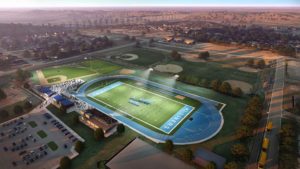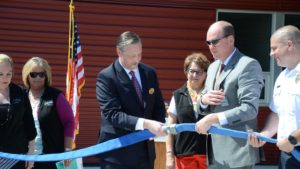Becker, K (2019, April 19). Building the Right Team. Retrieved from https://www.schoolbusinessaffairs.org/books/2019/2019-04-SBA/
INTRODUCTION
Everyone is invested in the local school district. We all want our schools to succeed and be a place for students to learn, grow, and thrive. When districts are faced with a building project to meet students’ needs, either through construction of a new facility, addition to an existing one, or a remodel of their current space, they face the challenge of making sure all invested stakeholders’ voices are heard.
Making sure everyone is heard sounds easy, but it can quickly turn into a ‘too many cooks in the kitchen’ situation. While everyone approaches change with different priorities and interests, the key to navigating diverse opinions is by putting together the right team to clearly communicate with stakeholders from beginning to end.
DISTRICT LEADERSHIP
The core of your team comes from district leadership, which consists of the superintendent, school board, and supporting committees who work directly with the design team. This leadership team leads the way through the project, making sure it stays true to the established project goals.
A building project is long and involves making a lot of tough decisions. Lee Dobrinz, project manager at JLG Architects, suggests that superintendents “take the time to understand their own desire and capabilities to lead the process…. [and] surround themselves with school board members, administration and staff who can provide quality input to the process. Plan up front for the time and cost needed for the district to lead the process. Lead but also delegate.”
Part of delegating means creating subcommittees and trusting them to make decisions. Forming a design committee to represent the district’s interests in the planning process is the first critical step to setting your project up for success. The design committee, made of up select school board members and district staff, are the voice of the board, staff, and the larger community when it comes to making decisions. Some of these committee members may not have in depth experience in design or building, and that’s ok. They just need the ability to respectfully balance the interests of all stakeholders with the budget. Steve Holen, Superintendent of McKenzie County Schools #1 in Watford City, ND, advises other districts starting the process to “[not] be afraid to ask others that have been through the process for advice or input. Visit other school buildings for ideas and ask what has worked well or hasn’t worked well with their designs. Have realistic expectations for the process and be prepared to make adjustments along the way as necessary.”
Establishing goals for the project is this groups first task. These goals act as a guide to which every decision made throughout the process should relate back to, so it is important that there is a clear understanding of the ‘why?’ motivating the project and what the top priorities are.
STAFF & STUDENTS
Staff and students are your biggest resource in understanding what is happening every day in the classroom and why facility improvements are needed. Their role includes participating in user group meetings held by the design team throughout the process. These user group meetings are opportunities for the design team to better understand what your teachers need in their room, spatial adjacencies within the building, and if the space supports their teaching methodology.
One of the key ingredients to creating a desire to ‘want to learn’ in our students is to create a space where they want to be.
This is why the design team should engage students in the process, because students know what they want and what they like in their learning environments. Including them in user group meetings uncovers what they want out of where they go to school. Maybe it’s a salad bar, or bigger lockers, or maybe it’s a treehouse in the media center. Whatever their ideas are – from the practical to the outrageous – the design team will work with district leadership to vet out which ones are feasible or if there are alternative ways to address those wants to make an engaging space for kids when they come to school.
COMMUNITY
The largest component of the team is the community at large; these are the tax payers who help fund your project. The building will have thousands of people interact with it over the years, all of whom have thoughts and opinions on what is important. Giving this group a voice in the process is crucial to a successful project.
Once it’s been decided at the district leadership level that a project is necessary to meet future needs, it is important to go out into the community and gather their thoughts on what is important for a school. According to Dobrinz, “the district (and architect) must gather real input from the community early in the process, show how it has guided the design, communicate back the reasons for decisions, and show the vision that the community and district have arrived at together.”
This community engagement should begin early in the process and take place through a series of community forums and workshops. These events allow the public to express concerns or goals for the project and have their voices be heard. Events like this are the place to educate community members on why a new building is needed by referring to the project goals established by district leadership. This helps the community understand the ‘why? ‘ behind a project. Is it to accommodate a growing population and overcrowded classrooms? Do the facilities no longer meet accessibility or health and safety standards? Do the spaces no longer support the way teachers teach or the way students learn? These are the issues that the public needs to know about in order to make informed decisions.
After passing a successful referendum vote in 2017, Superintendent of Luverne Schools in Luverne, MN, Craig Oftedahl reflected on his district’s experience of engaging the community with a collaborative team of program managers, architects, and construction managers. “We sent out lots of information and had a communication plan in place. We used the newspaper (almost weekly), the radio, and had meetings with staff employees regularly. We felt very good about the community input we received and used that to help foster our goals for the project.” Part of educating the public in Luverne included tours of the existing facility. After those tours, “everyone recognized the strength of the building and that [it] is a solid building, but to keep it relevant for the next fifty years, some changes needed to happen.”
Once the community is engaged in the discussion, make sure you go back to them again and again. Listen, report the findings back to the design committee, work out some solutions, then bring those concepts back to the community. Through all of this you should constantly communicate what is being done and why. Making sure the community is educated and feels listened to will go a long way in supporting a building project from idea stage through construction.
DESIGN TEAM
Throughout the project your design team walks right alongside you to help you navigate all phases from referendum through post occupancy. While teachers are the experts of the classroom, students provide insight into what makes an engaging learning environment, and the community provides financial and public support, your design team brings experience and knowledge of how to take all that information and shape spaces to support what your district is doing educationally. Along with the architect come other specialists that inform the design and construction of your project. These construction managers, owner’s representative/program managers, and design consultants, they are all there to support your vision and make your dream a reality.
According to Josh Kehrwald, Project Manager at JLG Architects, “[A district] should not expect to have someone come in and tell them what they need, rather they should have a partner that helps uncover and respond to those needs.” Your architect is your partner in this process guiding you through user group meetings with the staff and students to uncover the needs of the building’s users. Dobrinz emphasizes this point by noting that “communication is key. Always following the cycle of defining the problem, setting goals, following the design process to a solution and then following up at each stage of design to confirm the solution is meeting the goals. This sounds simple enough but is probably one of the hardest things we do.”
For a school district, building a new school or expanding current school facilities is an exciting time. A building project is a fluid process filled with new ideas, expectations that need to be managed, and unforeseen circumstances that can all make for an overwhelming experience. Make sure the project is a success by building the right team to lead the way and by the end of it you’ll have something the whole community can truly celebrate.
Katie Becker, LEED GA is a K12 Specialist for JLG Architects in Sioux Falls, South Dakota. Email: cbecker@jglarchitects.com
This article originally appeared in the April 2019 School Business Affairs magazine and is reprinted with permission of the Association of School Business Officials International (ASBO International). The text herein does not necessarily represent the views or policies of ASBO International, and use of this imprint does not imply any endorsement or recognition by ASBO International and its officers or affiliates.



